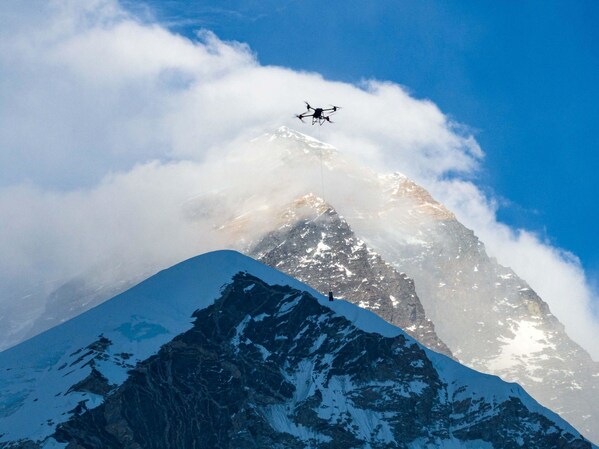SHENZHEN, China, June 5, 2024 /PRNewswire/ -- DJI has teamed up with Nepalese drone service company Airlift, video production company 8KRAW, and Nepalese certified mountain guide Mingma Gyalje Sherpa, to fly the world's first successful delivery drone trials on Mount Everest (Mount Qomolangma). Completed in April, this historic milestone in aviation highlights the impressive capabilities of DJI FlyCart 30, which can carry 15kg payloads even in the extreme altitude and environmental conditions of Mount Everest. During the tests, three oxygen bottles and 1.5kg of other supplies were flown from Everest Base Camp to Camp 1 (5,300-6,000m ASL). On the return trip trash was carried back down.
"From the end of April, our team embarked on a groundbreaking endeavor to help make cleanup efforts on Everest safer and more efficient," said Christina Zhang, Senior Corporate Strategy Director at DJI. "We are thrilled to share that our DJI FlyCart 30 was up to the task. The ability to safely transport equipment, supplies, and waste by drone has the potential to revolutionize Everest mountaineering logistics, facilitate trash cleanup efforts, and improve safety for all involved."
A Historic Achievement in Aviation
For the first time, drones have successfully completed the round-trip transportation of equipment and trash between Everest Base Camp and Camp 1. These camps are separated by the Khumbu Icefall, one of the most perilous stages of the ascent. While helicopters can theoretically make the same journey, they are rarely used due to the significant dangers and costs.
Before undertaking delivery flights, DJI engineers considered the extreme environmental challenges of Everest, including temperatures ranging between -15° to 5°C, wind speeds up to 15m/s, and high altitudes over 6,000m ASL. Rigorous tests of DJI FlyCart 30 were then conducted, including unloaded hover, wind resistance, low-temperature, and weight capacity tests with successively heavier payloads.
Delivering Safer Mountain Operations
Traditionally, the responsibility of transporting supplies and clearing trash on Everest has fallen on the shoulders of local Sherpa guides who may need to cross the icefall over 30 times in a season to transport supplies such as oxygen bottles, gas canisters, tents, food, and ropes.
"We need to spend 6-8 hours each day walking through this icefall," said Mingma Gyalje Sherpa, Imagine Nepal mountain guide. "Last year I lost three Sherpas. If we're not lucky, if our time is not right, we lose our life there."
The hazardous climb across the Khumbu Icefall typically happens at night when temperatures are lowest and the ice is most stable. An unmodified drone can carry 15kg between camps in 12 minutes for a round trip, day or night. DJI's delivery drones aim to ease the burden on Sherpas, who repeatedly risk their lives navigating the treacherous Khumbu Icefall.
Mount Everest Trash Cleanup
Each climber is estimated to leave 8kg of trash behind on Everest and, despite cleanup efforts, an estimated tonnes of waste remains on its slopes. If drone technology can ease this burden on cleanup crews, DJI is eager to help. DJI FlyCart 30 can efficiently transport garbage and human waste down the mountain, reducing the volume of trips Sherpas must make across the Khumbu Icefall.
Changing the Game- The Future of Drone Delivery
The climbing season of Everest is restricted to April and May, and further activities and drone testing are restricted for the rest of the year due to adverse weather. However, because of recent successful trials, the Nepalese government contracted a local drone service company to establish drone delivery operations on the southern slope of Everest starting on May 22.
The deployment of delivery drones in high-altitude regions not only promises to enhance safety and efficiency in these challenging environments but also highlights the importance of environmental conservation and sustainable practices within the mountaineering industry.
Launched globally in January 2024, DJI FlyCart 30 provides practical transportation solutions tailored to the unique needs and challenges of local users. It has been deployed to help plant saplings in steep hillside environments and line pulling in Japan, to transform solar PV installation in Mexico, to aid mountain fire rescue efforts in Norway, and to improve scientific research operations in Antarctica.
source: DJI
【與拍賣官看藝術】畢加索的市場潛能有多強?亞洲收藏家如何從新角度鑑賞?► 即睇


































